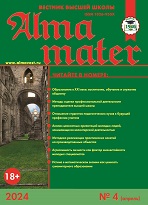UDC 316.4/.6-053
https://doi.org/10.20339/AM.08-22.033
Nikita A. Pozdeev, Assistant of the Department at Glazovsky State Pedagogical Institute named after V.G. Korolenko, e-mail: n-pozdeev@bk.ru
The article examines the risks of the lack of adaptation of the individual, during the transition from one social community to another. The interrelation of the concepts of “anomie”, violation and destruction of the frame, alienation at the personal level is considered. The theoretical analysis of sociological, pedagogical, philosophical scientific literature is carried out. The idea is proposed to consider the lack of adaptation of personality through such concepts as anomie, frame violations. The theory of anomie is considered through the views of E. Durkheim, L. Sroul and his indicators of individual anomie. Frame violations are studied through the works of I. Hoffman. The forms of self-alienation of personality, defined by M. Seaman, such as impotence, meaninglessness, normality, isolation, self-exclusion is considered in the conclusion of the article, the risks possible in the occurrence of these phenomena in the personality are presented.
Key words: anomie, alienation, frame violation, impotence, normality, meaninglessness, isolation, self-alienation, social pedagogy.
References
- Durkheim, E. O razdelenii obshchestvennogo truda [On the division of social labor]. Translated from French by A.B. Gofman. Moscow: Kanon Publ., 1996.
- Durkheim, E. The Division of Labour in Society (transl., in Rus.). Moscow: Kanon, 1996.
- Mannheim, K. Man and Society in an Age of Reconstruction. New York: Harcourt, Brace, 1940. P. 59.
- Nettler, G. A Measure of Alienation. American Sociological Review. 1957. Vol. 22 (December). P. 670–678.
- Riesman, D. The Lonely Crowd. New Haven & London: Yale University Press, 1950. P. 49.
- Riesman, D. The Lonely Crowd: A Study of the Changing American Character. New Haven &London: Yale University Press, 1961
- Seeman, M. On The Meaning of Alienation. American Sociological Review. 1959. Vol. 24. No. 6. P. 783–791.
- Seeman, M. A Prolegomenon on Empirical Research Regarding Anomie. In: Shoham, S. (ed.). Anomie and Alienation Revisited. Tel Aviv: Ramon Publishing Co., 1982. P. 121–138.
- Srole, L. A Comment on Anomy. American Sociological Review. 1965. Vol. 30. No. 5. P. 757–762.
- Srole, L. Social Integration and Certain Corollaries: An Exploratory Study. American Sociological Review. 1956. Vol. 21 (6). P. 709–716.
- Goffman, E. Analysis of Frames: Essays on the Organization of Everyday Experience. G.S. Batygin & L.A. Kozlova (eds.). Moscow: Institute of Sociology of the Russian Academy of Sciences, 2003. 752 p.
- Goffman, E. The Ritual of Interaction: Essays on Face-to-Face Behavior. translated from English: N.N. Bogomolova (ed.). Moscow: Smysl, 2009. 319 p.
- Lytkina, E.I. Operationalization of the concept of “anomie” in empirical research: analytical review. Sociology: methodology, methods, mathematical modeling. 2014. No. 38. P. 165–199.
- Lytkina, E.I. Social Structure in Three Theories of Anomie. Herald (Vestnik) of Tomsk State University. Philosophy. Sociology. Political Science. 2015. No. 1 (29). P. 176–184.
- Pozdeev, N.A., Volkov, A.B. The concept and components of socio-pedagogical adaptation of the student in the university. In: Research and Innovation: collection of articles of the X International Scientific-Practical Conference. Saratov: NOO “Digital Science”. 2021. P. 369–374.
- Fromm, E. A Healthy Society. Moscow: AST, 2015. 448 p.











.png)






